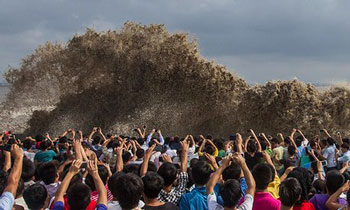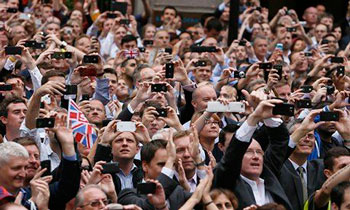Interesting take by the Guardian on whether smartphones kill photography. From presidential selfies to never-ending Instagram feeds, the world is now drowning in images. Some say we don’t even engage with the camera any more. We don’t know how it works. Photographers debate the impact of this mass democratization on their craft. Are camera phones destroying an art form?
Here some key excerpts:
Only two years ago Annie Leibovitz helped put the nails in the coffin of such middle market cameras by saying that the iPhone was the “snapshot camera of today.” But tomorrow? Maybe cameraphone functionality will become so superb that all you losers who spent four and five figure sums on digital SLRs will be overcome with buyers’ remorse and press snappers will be shooting with the same cameras as the rest of us?
Says Antonio Olmos, a 50-year-old, award winning Mexican photographer based in London:
It’s really weird. Photography has never been so popular, but it’s getting destroyed. There have never been so many photographs taken, but photography is dying.

People taking photographs of their food in a restaurant instead of eating it. People taking photographs of the Mona Lisa instead of looking at it. I think the iPhone is taking people away from their experiences.
But his real problem is the mentioned “democratization” of photography:

Now it’s the turn of professional photographers to join the scrap heap. Increasingly we don’t need photographers — we can do just as well ourselves.
It’s about photographers becoming obsolete. And not photography dying. Olmos:
Don’t get me wrong. I love iPhones and Instagram. But what I worry about is that Kodak used to employ 40,000 people in good jobs. What have they been replaced by? Twelve people at Instagram (…)
The iPhone has a crap lens. You can take a beautiful picture on the iPhone and blow it up for a print and it looks terrible.
Others lament digital’s laziness. Film and prints are foreign words for most of today’s photographers. Says Guardian photographer Eamonn McCabe:
For me the print is the ultimate expression of photography. When I do street photography courses, I get people to print pictures — often for the first time. The idea is to slow them down, to make them make — not just take — photographs. It takes me back to the days when photography didn’t make people like me lazy.
McCabe deplores the scattergun approach. You snap away thinking, “One of these shots will work,” rather than concentrate on capturing the image:
I don’t think photography’s dead, it’s just become lazy. People are taking lots of pictures but nobody’s looking at them.

Knight reckons the democratizing revolution catalyzed by improved mobile phone cameras is as radical as what happened in the 1960s when fashion photographer David Bailey binned his tripod and started using a handheld camera:
It gave him freedom and changed artistically what photography was. The same is true for me with the iPhone. For years I would shoot on an 8×10 camera, which wasn’t intended to be moved. Now I have freedom.
And what about the “crap” iPhone lens?
Who cares? The image isn’t sharp? Big deal! One of my favorite photographers is Robert Capa, whose pictures are a bit blurry sometimes — I love them because he’s captured a moment.
What I’m into is visual connection to what I’m taking, not pin-sharp clarity. It’s absurd for people to think all photos need to be high resolution — what matters, artistically, is not how many pixels it has, but if the image works. People fetishise the technology in photography more than any other medium. You don’t get anybody but paintbrush nerds fixating on what brush the Chapman brothers use. The machinery you create your art on is irrelevant.
Still, old guard photographer Olmos doesn’t worry:
I’ll survive in this profession because I have skills. I’m a storyteller in images; my compositions are better than most people’s. Just because you’ve got a microprocessor in your computer doesn’t make you a writer.


